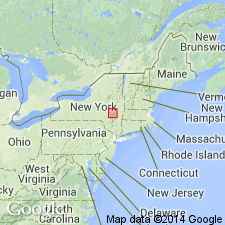
- Usage in publication:
-
- Basher Kill Tongue*
- Modifications:
-
- Named
- Dominant lithology:
-
- Quartzite
- Siltstone
- AAPG geologic province:
-
- Appalachian basin
Summary:
Named Basher Kill Tongue of Bloomsburg Red Beds for Basher Kill, north of Wurtsboro, Sullivan Co., NY. Consists of pale-red, light-olive-gray, pinkish-olive-gray, and light-brownish-gray, very fine-grained to granular, evenly bedded, thin- to medium-bedded, partly micaceous quartzite, grayish-red and brownish-gray to grayish-red-purple shaly siltstone, and pale olive and mottled grayish-red-purple siltstone. Unit probably conformably overlies the Ellenville Tongue of the Shawangunk Formation and underlies the Poxono Island Formation or the High View Tongue of the Shawangunk Formation. The Basher Kill Tongue is poorly exposed, but is probably as much as 330 feet thick near Port Jervis, NY and is about 33 feet thick at the type section. The lower contact of the Basher Kill is placed at the base of the first red bed above the Ellenville Tongue; the upper contact is covered by glacial drift. The Basher Kill Tongue is of Late Silurian age.
Source: GNU records (USGS DDS-6; Reston GNULEX).
For more information, please contact Nancy Stamm, Geologic Names Committee Secretary.
Asterisk (*) indicates published by U.S. Geological Survey authors.
"No current usage" (†) implies that a name has been abandoned or has fallen into disuse. Former usage and, if known, replacement name given in parentheses ( ).
Slash (/) indicates name conflicts with nomenclatural guidelines (CSN, 1933; ACSN, 1961, 1970; NACSN, 1983, 2005, 2021). May be explained within brackets ([ ]).

